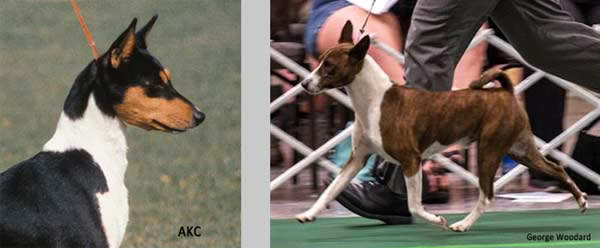The Basenji University
CLICK to return to The Standard Dissected
204 The Standard

Prepared by Susan Coe, Laurie Stargell and Pamela Geoffroy
Head
The Basenji Standard States:
The head is proudly carried. Eyes—Dark hazel to dark brown, almond shaped, obliquely set and farseeing. Rims dark. Ears—Small, erect and slightly hooded, of fine texture and set well forward on top of head. The skull is flat, well chiseled and of medium width, tapering toward the eyes. The foreface tapers from eye to muzzle with a perceptible stop. Muzzle shorter than skull, neither coarse nor snipy, but with rounded cushions. Wrinkles appear upon the forehead when ears are erect, and are fine and profuse. Side wrinkles are desirable, but should never be exaggerated into dewlap. Wrinkles are most noticeable in puppies, and because of lack of shadowing, less noticeable in blacks, tricolors and brindles. Nose--Black greatly desired. Teeth—Evenly aligned with a scissors bite.
The first portion of this section starts with head carriage: "The head is proudly carried" again emphasizes the proud bearing Basenjis display. The proud, high carriage on well arched neck is demonstrated by a still and a moving Basenji in the two photos above.

"Eyes—Dark hazel to dark brown, almond shaped, obliquely set ... Rims dark" are features well presented on this girl.

The range of eye color can vary quite a bit. Here is a brindle male with an intense expression with a different but acceptable eye color. The dog here and the one above give a range of desirable eye color for Basenjis. Again note how the eyes are obliquely set.

The term, far-seeing is used in sighthound standards and appears in the Basenji standard as well: "...and farseeing." It is an elusive term but a far-seeing eye would suggest the dog's ability to sight game at a great distance away and the concentration the dog would have when game is sighted. The dog will appear to be looking right through you. The standard has described expression differently in the past. A "puzzled expression" was described in the 1943 Standard. The 1954 Standard had no comments regarding expression. The 1990 Standard (the current version) introduced the words "Eyes...farseeing."
All owners are aware that the same Basenji can alter its expression amazingly by changing the eye shape, the ear set, what the mouth does, etc. Clearly they are able to show many expressions including teasing, serious, devoted, starving, laughing, disdain, mischievous, etc. but the Standard does not cover all the expressions Basenjis are capable of.
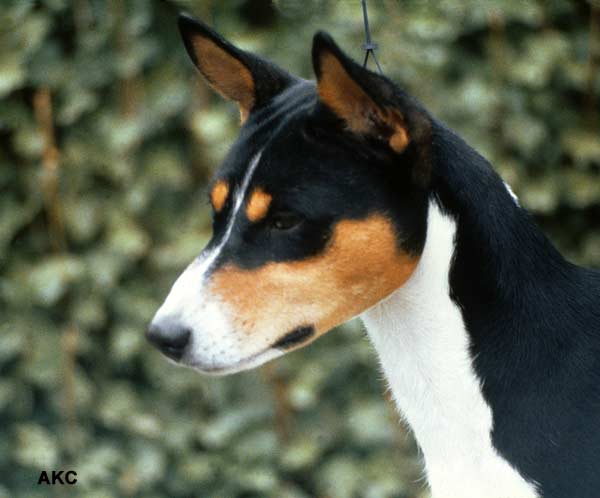
The photo above shows the ears as described in the Standard: "Ears—Small, erect and slightly hooded, of fine texture and set well forward on top of head." The ears are both slightly cupped in shape and tilted forward. From the profile the line formed by the arch of the neck continues along the back of the ears.

This photo of a trotting Basenji shows the ears correctly positioned right on the top of the head. The ability of the Basenji to hold the ears high, hooded and to swivel them in and out are important in making wrinkle and for the overall expression.

The series of photos above show a variety of ears in comparison. The dog on the left has long, narrow ears. The dog in the center has good ears in both size and set. The dog on the right has large, low set ears.

The photo above shows "The skull is flat," as seen from the side view. Also the line of the skull should be parallel to the line of the muzzle. A dish face or a domed skull is not desirable.

Additionally the skull should be "...well chiseled and of medium width, tapering toward the eyes." The words "well chiseled" mean that the modeling of the bone structure of the skull should be as if a skilled sculptor was involved making fine adjustments and that shape and modeling should show through the skin with flat plains, good transitions between plains and clearly visible brows.
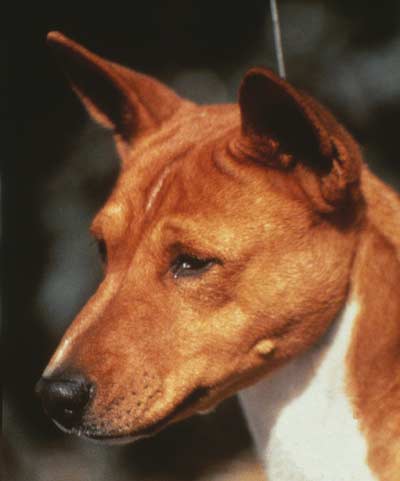
The foreface tapers from eye to muzzle..." means the skull tapers smoothly from the skull to the muzzle so that there is a smooth transition from cheeks into muzzle. The photo above shows the foreface tapering from cheeks for a smooth transition into the muzzle. A dog with head that looks like a squirrel with its mouth full of nuts is considered to be "cheeky." This is not desirable in a Basenji.
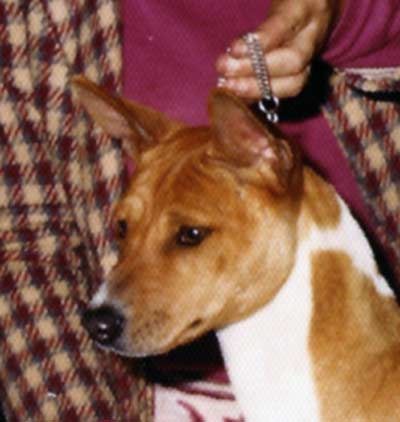
The sentence in the Standard continues with "... with a perceptible stop. "Stop" is the angle between the skull and the nasal bone (muzzle) near the eyes; it separates the two plains. The four photos above all show correct stop.
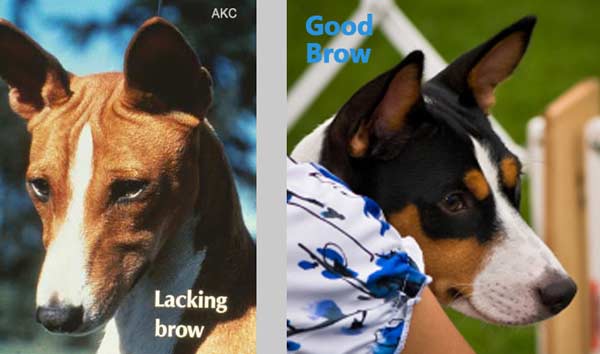
The brow line, the bony arch above each eye, is important to the shape and character of the head; the brows also protect the eyes from injury. The photo above on the left is a dog lacking the brow line making the head too flat and more streamlined than is typical of a Basenji. The photo on the right shows a good line of the brow, the ridge over the eye that ends the skull.
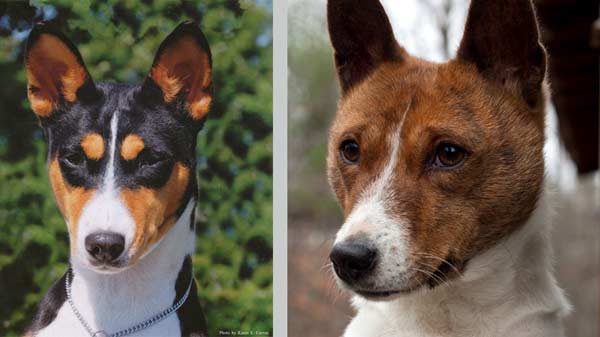
A cheeky appearance is seen when the taper between the skull along the side into the muzzle is too abrupt. This is not desirable. These two photos compare a good head on the left with a cheeky head on the right. Sometimes this cheekiness develops as the dog matures at about 3 years old.
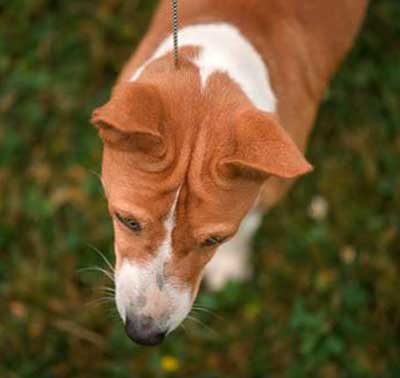
This 11-year-old male has kept the same head since he matured. The best heads do not become cheeky as the dog gets older.
As you breed, you will become familiar with how your dogs mature and will gain confidence in selecting the puppy head that will be correct when the dog has truly finished maturing.
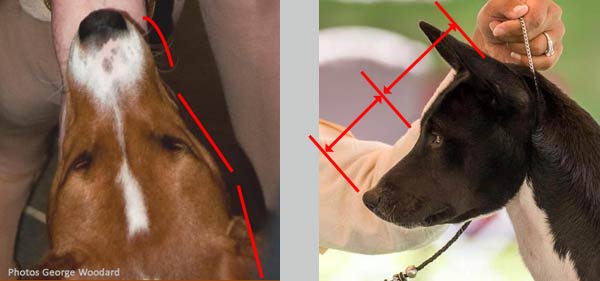
The head on the left above shows good transitions as indicated by the red lines. Transitions are smooth from the skull at the bottom, through the foreface taper into the muzzle and then into the rounded cushions as called for in the next sentence of the Standard: "Muzzle shorter than skull, neither coarse nor snipy, but with rounded cushions." The photo on the right with the head viewed from the side shows the muzzle is shorter than the skull. The Basenjis standard is not specific about these proportions therefore some variation in proportions can be accepted. In the past one heard the term "wedge-shaped" for the overall shape of the head. A very long head is typical of specialized sighthounds where aerodynamics is the most important consideration. A very long head with muzzle shorter than skull will give quite a different impression than wedge-shaped. Wedge shape would indicate the smooth side transitions as well as the general width as compared to the length of the entire head.
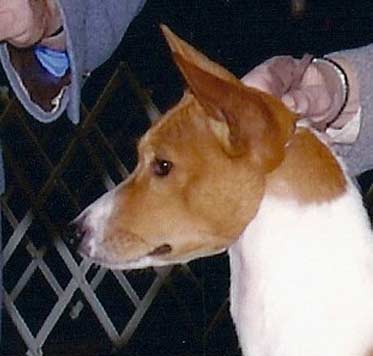
The clause "Muzzle...neither coarse nor snipy," is explained by Veronica Tudor-Williams in 1976: "Only a small amount of chin should show below the top lips too much lower jaw gives a square undershot look, sometimes called a hammer-jaw, but too little under jaw gives a snipy appearance." The dog in the photo above has a good underjaw without any appearance of being over done or over strong in the under jaw. Additionally, one needs to look at the muzzle from above to note that it is not overly pointed. See the photo showing transitions and cushion above for the correct top view. The cushioning helps keep the muzzle from being snipy or pointy as well.

"Wrinkles appear upon the forehead when ears are erect, and are fine and profuse." Lovely profuse wrinkles on both the red dog above and the black dog, however wrinkles are usually much harder to see (and especially to photograph) on the black and tricolor coats.
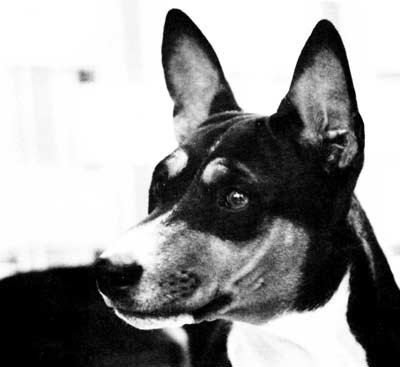
"Side wrinkles are desirable, but should never be exaggerated into dewlap." Side wrinkles are not often seen on adults but they are a desirable feature when present, as in the photo above. However, side wrinkle should never give the affect of the bloodhound or basset head with wrinkles dripping off the head making even a single fold hanging down. The lips fit smoothly to the mouth and there should be no flew or drooping at the corner of the mouth.
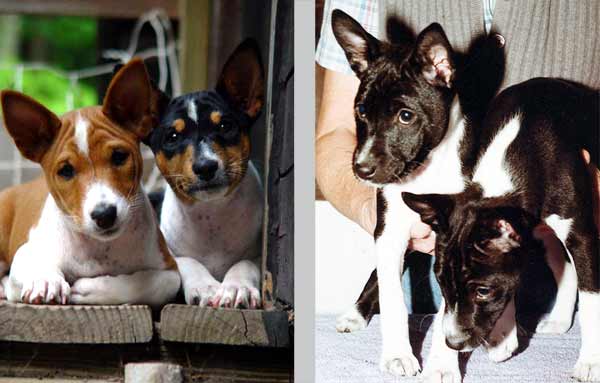
"Wrinkles are most noticeable in puppies, and because of lack of shadowing, less noticeable in blacks, tricolors and brindles." Two photos of puppies demonstrate how the shadows on the red puppy's wrinkles make them very clear. While the shadows do not show up on the black and tricolors since the black shadow is not so visible. This is especially true in some dark show buildings where wrinkles are hard to see on any color Basenji. Brindles Basenjis often have a complex pattern of dark stripes on their heads, which can hide and confuse the wrinkles' shadow lines as well.
Basenji wrinkle is not always visible. A relaxed dog, with his ears at half mast will not have wrinkle. But once that dog is animated with ears pricked up and forward and eyes gazing intently the wrinkles should appear.

"Nose—Black greatly desired." This is another interesting change from previous versions of the Basenji Standard. The description in the 1943 Standard was: "Black greatly desired, but a pinkish tinge should not penalize an otherwise first-class specimen." In 1954 this changed to: "Nose - Black greatly desired. A pinkish tinge should not penalize an otherwise first class specimen, but it should be discouraged in breeding." It was only in 1990 that the comment on the pink tinge was dropped entirely. The Basenji is not meant to be just a pretty face so the perfectly black nose should not be the only goal. The tricolor Basenji in the photo on the right above has a lovely head and a slightly pinkish nose. This is still a very nice head and an attractive Basenji.
Additionally some dogs with black noses tend to get a pinkish tinge in the winter when they do not get enough sunlight.
Sometimes there will be a puppy that takes quite a bit of time for the baby-pink nose to fully turn black. The pup can be approaching a year old when the nose completely fills in. That baby-pink color is quite different from the color on the nose of a dog like the one below.
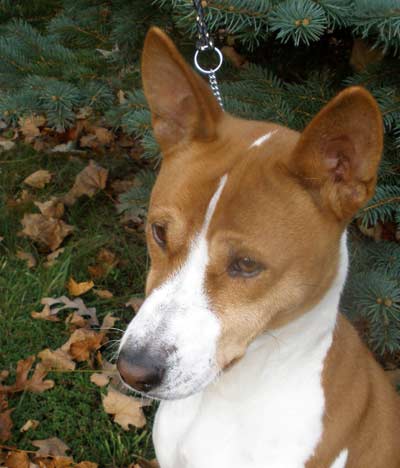
This photo shows a dog with a pink nose that stays that way all year. It is clearly faulty. The eye rims are similarly light. In fact this dog shows several faults including light eyes, a rather longish muzzle, some cheekiness and a head that is not at all wedge shape.
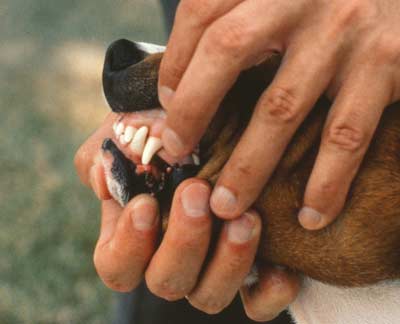
Functionally the teeth are very important and the Standard is quite clear: "Teeth—Evenly aligned with a scissors bite." "Even" as used in the Standard means the top jaw is in alignment in a horizontal position or relationship with the bottom jaw in a normal positions. Dogs sometimes have jaws that are slightly askew or crooked so the top and bottom jaws are out of alignment or not "evenly aligned." The photo above shows a scissors bite with the front teeth between the incisors like a pair of scissors with the upper teeth just on the outside of the lower teeth and the incisors themselves sitting against each other as shown.
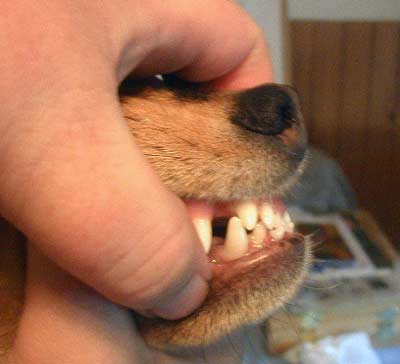
The photo above demonstrates an incorrect bite. Some of the upper teeth are inside the lower teeth and there is a space between the incisors. This is not as functionally strong a position for the teeth.
Sometimes dogs have teeth that sit on each other top to bottom without the top sliding inside or outside the bottom teeth. The problem with that jaw structure is that the teeth tend to wear down more than those on a dog with a correct scissors bite. To confuse things, this is sometimes called an even bite.
Comment on Section
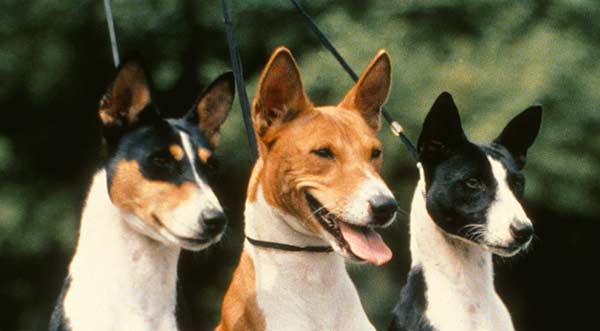
Remember that a Basenji's head is important in establishing correct type, but always consider the entire Basenji when planning your breeding program.
Copyright the Basenji Club of America 2013 CLICK to return to College for Basenji Breeders
Contact the Basenji University with comments, questions, updates and Workbooks at BasenjiU@basenji.org
.
We are indebted to the Basset Hound Club of America for the use of their Basset Hound University templates.
